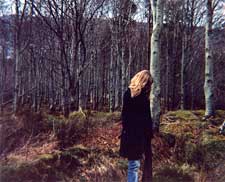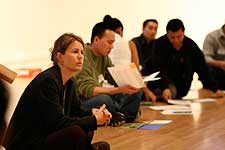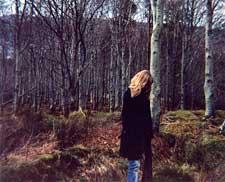
Marysa Dowling
Today, part II of artist Marysa Dowling's conversation with LACMA's Manager of School and Teacher Programs, Elizabeth Gerber. Yesterday's portion saw Gerber asking Dowling about the themes behind Journeys, Dowling's project on view at Charles White Elementary School as part of Art Programs with the Community: LACMA On-Site. As the conversation progressed, Dowling started asking the questions.
MD: What do you hope people will bring to this exhibition? Take from the exhibition?

Elizabeth Gerber
EG: Like you, I hope that with careful looking at the artwork, visitors will see something new in this city, or consider different ways they can look at their own neighborhoods or familiar journeys. I hope people will bring an interest in seeing new artwork and in learning how some of the young people in Los Angeles view their schools and neighborhoods. And I hope that the broad role that LACMA can have in this city, and of museums generally, is refreshed and reinforced. I too hope that the collective portrait presented in the exhibition continues to grow over time.
MD: Why are these types of projects important to LACMA?
EG: The museum supports an incredible amount of work with students and teachers; a project such as this one encourages art making and discussions with students and teachers—as well as their families, friends, and neighbors—outside of a traditional classroom setting. A project that is based in different neighborhoods throughout Los Angeles allows the museum to engage with the interests and concerns of multiple neighborhoods, and to work with individuals who might not have previously visited LACMA. Ultimately, projects that create new and dynamic works of art, build community, engage with audiences, and educate (in the broadest possible sense) are critical to furthering LACMA's mission.
MD: Why is it important to commission artists?
EG: I am actually very interested to see the response that we receive to this question here on Unframed, as the importance of commissioning artists and the type of work that should be commissioned is a fascinating topic for discussion. From my perspective, the museum has the opportunity to foster the creative process and to share it more broadly with others through these types of commissions.
When it comes to commissioning artists to work with students, there are a range of important benefits. In addition to the creation of new work, the time and energy that you shared with the participants can have a large impact: so often we hear from teachers and principals about the importance of artists as role models for their students. With this project, you introduced David Hockney's Mulholland Drive: The Road to the Studio as an artwork for students to view and discuss, leading them to consider their own journeys through Los Angeles. At LACMA we often try to view our encyclopedic collection through a contemporary lens, and artists are very good partners in this endeavor. There's always a risk when new work is created, but in my opinion, that risk is an interesting and important element as well.
MD: In what ways could this project connect with other cities?
EG: We live in an increasingly global world, where images and information can travel at an incredibly rapid rate. At the same time, localities matter—and they matter a lot. In my mind, a project like this does an excellent job of highlighting the similarities and differences of cities, and the people who live in them. At its core, an institution like LACMA provides opportunities for people to learn about cultures throughout time and around the world.
For more information on this exhibition, including directions and hours, click here.



